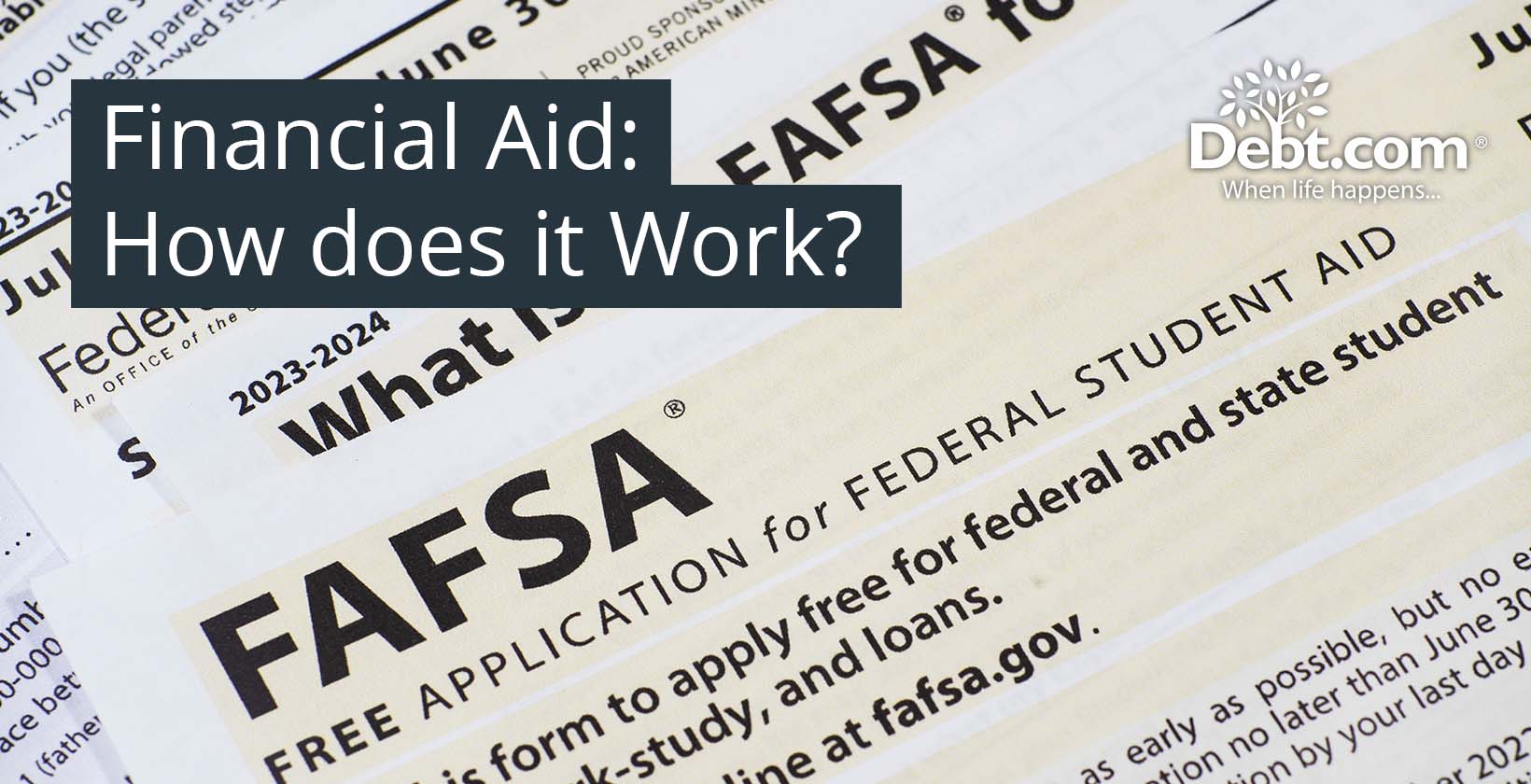
Financial aid is the funding and resources provided to families and students to help cover higher education costs, including tuition, books, accommodation, and other expenses. The primary purpose of financial aid is to increase accessibility and affordability for students from all socioeconomic backgrounds, helping to remove financial barriers and ensure equal opportunities.
Financial aid works by offering various types of support, including grants, scholarships, loans, and work-study programs. Grants and scholarships are forms of money for college that do not require repayment and are awarded based on financial need or academic merit. Loans provide funds that must be repaid with interest, while work-study programs offer part-time employment to help cover college expenses.
The financial aid process begins with completing financial aid applications, such as the Free Application for Federal Student Aid (FAFSA) and, for some private universities, the CSS Profile. These applications allow colleges to assess financial needs and determine eligibility for different types of aid. Colleges submit financial aid offers after reviewing each application. These offers detail the total amount of financial aid, which includes non-repayable scholarships and grants and repaid loans.
The financial aid college office applies the aid to the student’s account, with any remaining funds available for additional costs. Students must renew their FAFSA annually, as much of the information is reused from the previous year. Financial aid does not always cover the entire cost of education, and students need to seek additional funding if their financial situation changes or if they receive better offers from other institutions.
Table of Contents
What is Financial Aid?
Financial Aid is the funding and resources provided to families and college students to help cover higher education costs. Financial aid includes books, supplies, accommodation, board, tuition, fees, and other related charges. “Financial aid meaning” refers to various programs and grants designed to reduce the cost of obtaining a higher education.
The primary purpose of financial aid is to increase accessibility and affordability for students from all socioeconomic levels. It aims to remove financial barriers, enabling more students, especially students from low-income families, to attend college. Need-based and merit-based aid ensures equal opportunities for all students regardless of their financial backgrounds.
Financial aid improves student achievement by alleviating the financial burden of college expenses, allowing students to focus on their academics and perform better. It supports diverse enrollment by making college more affordable for students from underrepresented backgrounds, fostering a more inclusive student body.
What is FAFSA?
FAFSA (Free Application for Federal Student Aid) is a form that students must complete to receive federal financial aid for college. It collects financial information from the student and their family to assess eligibility for various types of aid, including government grants, work-study funds, and loans. States and universities use FAFSA data for their aid programs. FAFSA is available starting October 1st of each year, and states and institutions set early deadlines. The FAFSA calculates a Student Aid Index (SAI). SAI is a measure to assess a student’s financial need and determine their eligibility for need-based financial aid. Completing the FAFSA is necessary for federal student loans and other forms of assistance, even if need-based aid is not anticipated.
What is the Importance of Financial Aid?
The importance of Financial Aid lies in its ability to make college more affordable, particularly for students from lower and middle-income families. Financial aid determines whether a student is eligible to attend college by providing financial support.
Financial aid facilitates access to higher education by allowing more students to pursue a college degree, regardless of their financial situation, thus promoting equal access and social mobility.
Financial aid reduces student loan debt. Work-study, grants, and scholarships lower the amount students need to borrow, resulting in less debt upon graduation. It alleviates financial stress, improves academic performance, and increases retention and graduation rates.
A degree supported by financial aid enhances career opportunities and earning potential, improving long-term financial stability and quality of life. Financial aid encourages increased enrollment, particularly among historically underrepresented groups, benefiting individuals and society.
How does Financial Aid Work?
Financial aid works by providing financial resources to students to help cover the costs of higher education. Financial aid includes grants, scholarships, work-study programs, and loans but does not include personal savings or family contributions. It covers educational expenses such as books, tuition, and room and board.
The two main types of financial aid are need-based and merit-based. Need-based aid is determined by the student’s and their family’s financial situation, while merit-based aid is awarded based on artistic, athletic, or academic achievements. Various sources provide financial aid, including federal and state governments, colleges, community organizations, and private foundations.
Financial aid applications require students to complete specific forms, such as the Free Application for Federal Student Aid (FAFSA) and the CSS Profile for many private universities. These applications allow colleges to assess financial needs and determine eligibility for different types of aid. FAFSA must be submitted immediately, ideally on or before October 1st of the preceding year.
Colleges send acceptance letters and financial aid offers after reviewing applications. These offers detail the total amount of aid, specifying whether it includes non-repayable grants and scholarships or repayable loans. The amount of aid granted varies significantly based on financial needs and institutional policies.
The college’s financial aid office applies the aid to the student’s account, with any remaining funds available for additional costs. Students must renew their FAFSA annually, as much of the previous year’s information is reused.
Financial aid does not cover the entire cost of education, and students request additional funding if their financial situation changes or they receive a better offer from another institution. It is a misconception that higher income automatically disqualifies a family from receiving aid, as factors such as the number of family members in college are considered. Early planning and exploring various funding options are crucial for managing education expenses and securing financial aid.
What are the Types of Financial Aid?
The types of financial aid are listed below.
- Grants: Grants are financial aid that do not require repayment and are awarded based on financial need. Sources include federal and state governments, institutions, and private organizations. Grants help cover expenses like tuition and fees, alleviating the need for loans and reducing financial stress.
- Scholarships: Scholarships are financial awards for academic performance, athletic abilities, or other achievements that do not need to be repaid. Colleges, universities, private organizations, corporations, and non-profits provide them. Scholarships reduce the need for student loans by covering tuition, books, and housing and include networking and mentoring opportunities.
- Loans: Loans are funds borrowed by students that must be repaid with interest. They cover educational costs such as tuition, fees, and living expenses. Loans offer deferred repayment, allowing students to focus on their studies before starting to repay.
- Work-Study: Work-study is a financial aid program providing part-time employment opportunities for students, based on financial need. Earnings help cover various college expenses, and the work experience gained is relevant to the student’s field of study, enhancing career prospects.
1. Grant
A grant is a form of financial aid provided to students that does not require repayment, making it one of the most advantageous types of assistance. Grants are granted based on financial need and come from federal and state governments, institutions, or private organizations. They offer “free money” to help cover expenses such as tuition, fees, and other related costs, eliminating the debt burden.
Grants relieve the financial burden of education, allowing students to focus on their studies without worrying about accumulating loan debt. They enhance access to higher education by reducing financial stress.
Grant recipients gain access to additional academic opportunities, such as research projects and internships, which are essential for career advancement. Grants enhance a student’s resume by demonstrating financial responsibility and educational commitment. A Grant is a valuable resource for easing financial burdens and achieving educational goals.
2. Scholarship
A scholarship is a financial award given to students based on their academic performance, athletic abilities, or other achievements that do not require repayment. Scholarships are provided by entities such as colleges, universities, private organizations, corporations, and non-profits. They help alleviate the financial burden of tuition and related expenses, serving as a crucial educational funding source.
Scholarships reduce financial stress by covering essential costs like tuition, books, and housing, which lowers the need for student loans. The aid allows students to focus on their studies rather than working long hours to fund their education.
Receiving a scholarship highlights a student’s hard work and achievements, enhancing their resume and employability. Scholarships grant access to prestigious institutions, providing better learning opportunities and connections with renowned faculty.
Scholarships offer networking and mentoring opportunities, connecting students with professionals and alumni in their fields, which offer valuable career insights and potential job prospects.
3. Loans
Loans are a type of financial aid in which students borrow funds that must be repaid with interest over time. The borrower receives a specific sum and agrees to repay it according to the loan terms, which differ from grants and scholarships. These funds cover educational expenses such as tuition, fees, and living costs, while the borrower assumes responsibility for repaying the borrowed amount.
Loans are beneficial for students as they cover essential costs like tuition, housing, and textbooks. The financial support allows students to attend college and focus on their studies without immediate financial pressure. Student Loan offers deferred repayment, enabling students to concentrate on their education before starting to repay the borrowed funds. Loans provide the necessary funds to manage financial obligations and achieve academic goals.
4. Work-Study
Work-study is a financial aid program that offers part-time employment opportunities to students, allowing them to earn money for college expenses. Eligibility is based on demonstrating financial need through the Free Application for Federal Student Aid (FAFSA). The program is available to participating institutions’ undergraduate, graduate, and professional students.
Work-study helps students by providing funds for various expenses such as living costs and tuition. Earnings are paid as paychecks, which students use for everyday needs like transportation and food, rather than directly applied to tuition.
The work-study program gives students valuable work experience and helps develop transferable skills related to their field of study. Many positions align with academic interests, offering opportunities for professional networking and real-world experience. The combination of income and career readiness enhances job prospects after graduation.
What is the Best type of Financial Aid to Accept?
The best types of financial aid to accept are grants and scholarships. These aids are preferred because they do not require repayment. Grants provide financial support and are granted based on financial need by federal, state, or educational organizations. Scholarships are merit-based, come from schools, private organizations, and community groups, and offer support without repayment obligations.
Grants and scholarships significantly reduce the financial burden of education by covering tuition, fees, and other expenses. Examples include the Pell Grant, a federal grant for undergraduates with financial need, and merit-based scholarships awarded for academic, athletic, or artistic achievements.
Scholarships and grants are highly advantageous, but understanding eligibility requirements and the application process is crucial. Grants require proof of financial need, whereas scholarships require specific academic or extracurricular accomplishments. Additional essays or applications are needed. Prioritizing grants and scholarships helps minimize debt and provide greater financial stability during and after one’s education.
What Type of Financial Aid is Free Money?
Free money is a type of financial aid that does not require repayment and includes grants and scholarships. Free money is awarded based on specific criteria such as academic performance or financial need.
Grants are given based on financial need and do not require repayment, except in cases where conditions are not met. Examples include the Federal Pell Grant and Federal Supplemental Educational Opportunity Grants (FSEOG).
Scholarships are given for exceptional talent or academic achievement and do not require repayment. They come from various sources, such as foundations, colleges, and private organizations.
The Federal Work-Study program, such as the Pell Grant, provides funds for education, but it is not considered free money since it requires students to work to qualify. It differs from grants and scholarships, which do not require repayment.
Understanding the difference between free money and other financial aid forms, such as student loans that require repayment, is crucial for making informed financial decisions.
How is Interest Rate Accrued in Financial Aid?
The Interest rate accrued in financial aid is calculated based on a portion of the loan’s outstanding principal. The interest accumulates over time and significantly impacts the repayment after graduation.
Student loan interest accrual is determined using a simple interest method for federal loans, where interest is computed only on the principal balance. Private loans use compound interest, which is charged on the principal and accumulated interest, increasing the total debt.
Interest begins to accrue as soon as the loan funds are disbursed. It includes a grace period after graduation or dropping below half-time enrollment, during which interest accrues on unsubsidized loans. The government covers interest on Direct Subsidized Loans during the grace period, reducing the borrower’s financial burden.
Interest capitalization happens when unpaid interest is added to the principal balance, leading to higher repayment amounts. It occurs when a borrower starts repayment after the grace period, and future interest is calculated based on the increased principal.
Students have the interest-only payment option to manage interest costs. Understanding how interest accrual for student loans works helps borrowers manage repayments and reduce financial strain.
Do I Have to Pay Back Financial Aid?
Yes, you have to pay back financial aid if it is in the form of loans, and no, if the aid is a grant, scholarship, or earned through a work-study program. Grants and scholarships do not need to be repaid unless specific conditions are met, while work-study funds are earned through employment. All loans, whether federal or private, must be repaid with interest.
How to Consolidate Financial Aid?
To consolidate financial aid, particularly student loans, start by understanding the benefits, applying for consolidation, and selecting an appropriate repayment plan. Loan consolidation simplifies repayment by combining multiple loans into a single loan, resulting in one monthly payment and potentially lower monthly payments. Loan Consolidation provides access to income-driven repayment plans and potential forgiveness options, offering further financial relief.
A consolidation application is submitted electronically on the Federal Student Aid website or in writing by mail. Borrowers must choose which loans to include and select a repayment plan that fits their budget. The online application is straightforward and takes about 30 minutes to complete.
The borrower has various repayment options once the loan has been approved. The Standard Repayment Plan repays loans over a fixed period (10 years), extendable to 30 years for consolidation loans. Income-driven repayment plans adjust payments based on income and family size, while graduated repayment starts with lower payments that increase over time. Choosing the right plan is crucial as it impacts future financial commitments and management.
How is Financial Aid Calculated?
Financial aid is calculated by the six steps listed below.
- Complete the Free Application for Federal Student Aid (FAFSA) to gather information about the student’s and family’s financial situation.
- Determine the Expected Family Contribution (EFC) using the FAFSA information to estimate how much the family contributes towards college costs.
- Establish the Cost of Attendance (COA), which includes all expenses related to attending the school, such as tuition, fees, and living costs.
- Calculate financial need by subtracting the EFC from the COA using the formula: Financial Need = COA – EFC.
- Evaluate enrollment status (full-time, half-time, etc.) as it affects the amount and type of financial aid available.
- Create a financial aid award package, which includes a combination of grants, scholarships, loans, and work-study based on the calculated financial need and the school’s policies.
What Factors are Considered when determining eligibility for Need-Based Financial Aid?
The factors considered when determining eligibility for need-based financial aid are listed below.
- Income: Taxable and non-taxable income are assessed. Lower incomes lead to higher financial aid eligibility. The information is used in the Student Aid Index (SAI), which replaces the Expected Family Contribution (EFC).
- Assets: Student and parental assets are evaluated differently. Student assets contribute 20% to the EFC, while parental assets contribute 5.64%. Retirement funds and primary residences are excluded, but savings accounts, investments, and specific real properties are considered.
- Household Size: Household size Impacts the income protection allowance, reducing the amount of income considered available for educational expenses. It includes the student, their spouse (if applicable), and any dependents the family supports.
- Number of Family Members in College: The EFC was previously divided among family members, lowering the contribution per student. The new SAI formula does not include the division, potentially increasing the contribution and reducing aid for families with multiple college students.
- Cost of Attendance (COA): COA represents the total expenses for attending school, including tuition, room and board, and additional fees. Financial need is determined by subtracting the COA from the SAI.
- Expected Family Contribution (EFC): The EFC, based on FAFSA information, shows how much a family contributes to college costs. It includes household size, number of college students, income, and assets and is crucial for determining need-based financial aid eligibility.
How do Merit-Based impact the Financial Aid Package?
Merit-based aid impacts the financial aid package by influencing aspects of financial planning, such as reducing unmet needs and lowering need-based aid. Merit-based helps bridge the gap between the cost of attendance and what other forms of aid cover, possibly reducing the need for loans or out-of-pocket payments. It helps institutions meet all documented financial needs.
Significant merit-based scholarships reduce need-based aid, as total assistance is unable to exceed the cost of education. It affects work-study or loan components, potentially lowering debt or employment needs. Receiving merit-based aid prompts reevaluating financial needs, altering the overall aid package.
Merit-based scholarships come with renewal requirements, such as maintaining a specific GPA. Failure to meet these standards leads to losing the scholarship and increased reliance on other financial aid. Merit-based aid provides more consistent support, allowing for strategic decisions on school choice and borrowing.
Is the Forgiveness Program available in Financial Aid?
Yes, the forgiveness program is available in financial aid. The Forgiveness Program encompasses efforts to reduce or eliminate student loan debt under specific conditions. Key programs include state-specific forgiveness programs, Perkins Loan Cancellation and Discharge, Income-Driven Repayment (IDR) Forgiveness, Teacher Loan Forgiveness, and Public Service Loan Forgiveness (PSLF).
Public Service Loan Forgiveness (PSLF) is available to borrowers employed full-time by qualifying employers, such as government or non-profit organizations. The remaining loan balance is forgiven after ten years if the borrower makes 120 qualifying monthly payments under an approved repayment plan.
Teacher Loan Forgiveness benefits educators who work in low-income schools or educational service agencies for five consecutive years. Qualified teachers have up to $17,500 forgiven on Direct Subsidized and Unsubsidized Loans and Subsidized and Unsubsidized Federal Stafford Loans.
Income-Driven Repayment (IDR) Forgiveness applies to borrowers on income-driven repayment plans like REPAYE, PAYE, or IBR. The remaining loan balance is forgiven after 20-25 years of payments.
Perkins Loan Cancellation and Discharge is for borrowers working in specific fields, such as education, healthcare, or the military. A portion of the loan is canceled for each year of service in these professions.
State-specific forgiveness programs offer varying eligibility and benefits based on profession and location, targeting public sector workers like teachers and healthcare professionals.
Student Loan Forgiveness options help borrowers reduce their debt burden, provided they meet the specific criteria and follow the respective application procedures.
How can Students avoid Financial Aid scams and Fraudulent offers?
Students can avoid financial aid scams and fraudulent offers by exercising caution and following essential practices. Unsolicited scholarship offers via letters or emails, particularly ones saying students have won awards they did not apply for, must be treated with suspicion as they indicate a scam.
Identifying warning signs of financial aid fraud is crucial. Red flags include aggressive language, offers that seem too good to be true, requests for upfront payments, or demands for personal financial information. Be wary of communications with errors, unofficial contacts, or high-pressure tactics.
Students must rely on trusted resources like local guidance counselors and the Free Application for Federal Student Aid (FAFSA) to find financial aid and scholarships. Most legitimate scholarships do not require an application fee.
Avoid paying for aid services. Scammers often demand fees to process awards or scholarships. The FAFSA and financial aid application processes are free.
Verify the legitimacy of any financial aid company before engaging with them. Conduct thorough research, check reviews, confirm credentials, and ensure accurate contact information. Reputable companies must be transparent and responsive.
The Better Business Bureau or the Federal Trade Commission must be contacted if students suspect a scam or fraudulent offer.
Review agreements or conditions carefully before signing. Understand refund policies and fees, as dishonest companies make it difficult to recover money. Students must seek advice from trusted sources like school financial aid offices or professional financial advisors if they have doubts. These practices significantly reduce the risk of financial aid scams and help secure legitimate funding options.
Students must seek advice from trusted sources like school financial aid offices or professional financial advisors if they have doubts. These practices significantly reduce the risk of financial aid scams and help secure legitimate funding options.









